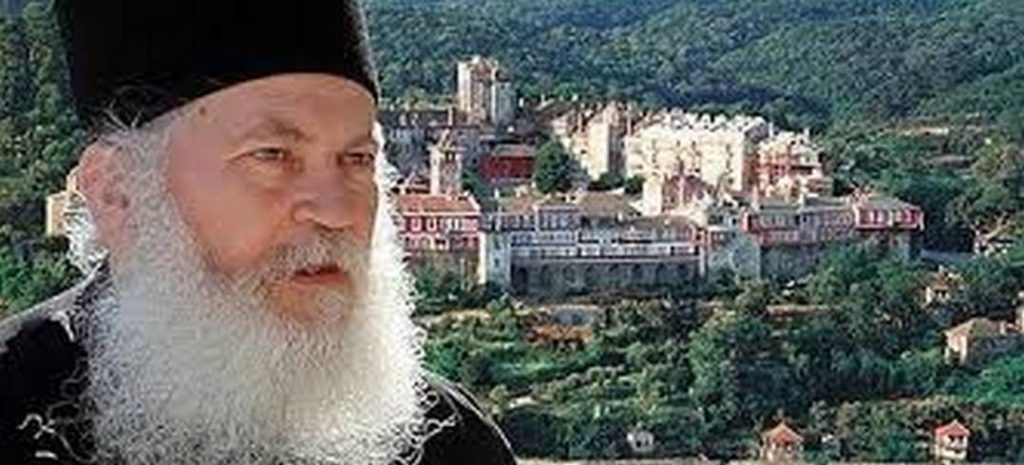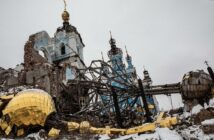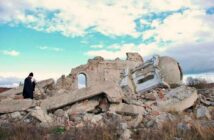Source: The National Herald

Abbot Ephraim of Vatopedi Monastery on Mount Athos
MOUNT ATHOS, GREECE – Elder Ephraim, Abbot of the Great Vatopaidi Monastery of Mt. Athos gave an extensive interview to The National Herald, which follows.
TNH: Elder Ephraim, is this your first visit to America? What is the aim of this forthcoming visit?
EE: This will be my second visit. I went to Arizona in 2011, to St. Anthony’s Monastery, to meet Elder Ephraim, now of Arizona, formerly of Filotheou, who is a spiritual brotherof my late Elder, Iosif. Both of them had the blessed Elder Iosif the Hesychast as their spiritual father. It was an unforgettable meeting.The occasion for this second visit is that, for three years now, Metropolitan Alexios of Atlanta has been asking us to bring to his See a copy of the wonderworking icon of Our Lady the Vimatarissa, which is kept in our Monastery. A variety of obligations have so far prevented us from doing so, but, God willing, we’ll take a copy of the icon to America at the end of September.
TNH: Would you please speak to us briefly about your Monastery, Vatopaidi. What state was it in when you first went there and took over and what is it like now?
EE: The Holy and Great Monastery of Vatopaidi is a historic monastery, the second in rank in the hierarchy of monasteries on the Holy Mountain. According to its manuscript traditions, its foundation can be traced to the time of Emperor Theodosius the Great, that is the end of the 4th century. In the 10th century,St. Athanasios the Athonite directed three lords from Adrianople, Nikolaos, Athanasios and Antonios, to renovate the Monastery of Vatopaidi, which had been sacked by pirates. Thereafter, the Monastery prospered throughout the Byzantine period, under the protection of various emperors, providing the Church of Christ with a whole host of saints such as Gregory Palamas, who was clad in the monastic habit in the Monastery by his Elder, St. Nikodimos the hesychast.
They lived the ascetic life together in a hermitage opposite the Monastery. Sts. Savvas, the first Archbishop of Serbia, and his father,Symeon, the first ruler of Serbia and from whose relics myrrh flows, took the Orthodox Tradition back with them to Serbia and revived the Church there. St. Maxim the Greek was sent by the Monastery to lend spiritual support to the Church of Russia in the 16th century. A great many other saints and personalities from the Monastery have adorned the notional firmament of the Church. In the Monastery we have the grace-filled and wonderworking Holy Girdle of Our Lady, Mother of God, the skulls of Sts. John Chrysostom and Gregory the Theologian, a host of other holy relics and many other sacred relics such as the jasper chalice of Matthaios Kantakouzinos, the rock crystal goblet ofThomas Preljubović, and the Shroud and Gospel of Ioannis Kantakouzinos. All these were gifts from Byzantine emperors. Endowed by its holy founders with a great many dependencies, it played an important role in the history of the Greek nation, providing assistance for its education and its struggles for freedom.
In the post-Byzantine era, the Monastery was idiorrythmic for roughly 500 years until it became a coenobium under our own community. After about 1930, the Monastery declined spiritually and materially. When our Elder, Iosif, was invited in with our brotherhood, in 1987, there were only a few monks left to run the Monastery and open the church for rudimentary services. In 1990, by a resolution of the Ecumenical Patriarchate and the Holy Community of the Holy Mountain, it changed from idiorrythmic to coenobitic. Then my humble self was installed as the first Abbot of the Monastery for 500 years. By God’s Grace, since then we have begun the multifaceted task of restoring the buildings (covering 35,000 square metres in the Monastery proper and more than 50,000 in the Sketes and Kellis subject to it, all of which need some form of restoration); conserving the treasures (more than 3,500 icons, 2,200 manuscripts, 350,000 documents, 40,000 antique books, a great many works of gold embroidery and silverware, which had been neglected, left to rack and ruin and in need of restoration and conservation); welcoming visitors; publishing (with many soul-stirring, scientific, cultural, and musical works which have won awards from the Academy of Athens and other European agencies); and, insofar as we’re able, performing works of charity. But our main task is the spiritual guidance and direction of the whole brotherhood, in the spirit of the Athonite hesychast tradition, in accordance with the spiritual legacy handed down to us by our Elder, Iosif Vatopaidinos and our spiritual grandfather Iosif the Hesychast.
TNH: Do you believe that monasticism today continues to be the “joyful mourning of the Church” and that the monastics are the eschatological signs of the kingdom of God on earth, or has there been some alteration of their ascetic and eschatological ethos?
EE: The great danger for the Church and for monasticism today is secularism. When we say secularism, we mean that the secular outlook is gaining ground and altering the Orthodox experience, Orthodox Tradition. The secular outlook is love of self, complacency, greed, hedonism, hostility, generally being content with ourselves as opposed to other people. That’s the way the world lives. But the world must become the Church, not vice versa. So, as long as monasticism isn’t secularized, but continues to live along the lines of the Fathers, in accordance with Orthodox ascetic Tradition,then monastics will continue to be the “joyful mourning of the Church” and the eschatological signs of the kingdom of God on earth. Monastics who experience divine Grace, sanctity, already live in the kingdom of God. They experience the last things even in this life.
TNH: Please explain to us, especially to young people, what monasticism is, what its aim is in the present era.
EE: Monasticism is the nerves, the spinal cord of the Church. Within monasticism, the Gospel is experienced in a precise and genuine manner, in every day and age. Monastics devote themselves entirely to God. They don’t feel merely a call, but an attraction to Christ Himself. Christ says in His Gospel: ‘People can’t come to me unless the Father who sent me draws them’ (John 6, 44). When monastics feel this attraction, this desire, thirst for God, great love for Christ, they reject everything: family, academic and professional career, themselves. In monastic terminology, they renounce the world, go to some monastery and are obedient to some Elder. They don’t leave the outside world because they hate it, but because they’re attracted by Christ for a fuller acquaintance and union with Him. They don’t reject the world, communal society, but the secular outlook, which is why they seek true communion in Christ. In the monastery, far removed from secular stimulation, they find ideal conditions for the achievement of their personal sanctification. They become acquainted with, and love, Christ in a particular, personal manner. Communion with Christ becomes empirical, ontological, regenerative, therapeutic, enlightening, and divine. They then begin truly to love their neighbor, other people, everyone else, those in need or sorrow, even their enemy.
In other words, this action, renunciation of the outside world and entry into a monastery, which at first sight seems anti-social, becomes the springboard for the cultivation of true communion with one’s neighbor. You can’t really love God if you don’t love your neighbor, who is made in God’s image. In a natural way, love for other people flows from love of God. Because the double action of love, for God and for other people, has the same source, Christ, Who is love incarnate and crucified. ‘God is love’ (I John 4, 8). Monastics then begin to pray for repentance, for the salvation of the world, but in a unique manner, which is sacrificial. And the prayers of such monastics, who live selfless lives, in obedienceand always subject to God’s will are heard by God. Their prayers support the whole world. These monastics have joined the family of Christ, Who is God and human, and have become people concerned with the whole world. This is the main, the essential contribution of monasticism to the world: prayer for the salvation of the world.
An additional, important contribution of monastics to the lives of people today is their way of life, their example. When lay people visit a monastery, they take away the example of the monks or nuns, their words, their silence, their prayer, their whole attitude and religious disposition. These lay people take leaven, they’re nourished spiritually and recharge their batteries when they visit a monastery. Then when they return to their family “in a different form,” the other members will also benefit spiritually. So monastics contribute to the invigoration and spiritual improvement of the life of parishes.
TNH: Elder Ephraim, can you please explain to the Greek-Americans why there is a prohibition on women entering the Holy Mountain? Why is there a distinction between men, who may enter, and women, may not?
EE: This is a question asked by many people whom we meet outside the Holy Mountain. “But why can’t women enter the Holy Mountain? That means that the monks don’t want women.” And we answer that they are forbidden entry not because the monks are misogynists. Monks reject neither women nor marriage. St. Paisios the Athonite used to say that a good monk could have been a good head of a family. Monks avoid marriage, not because they hate it, but to pursue something higher. Women are not allowed on the Holy Mountain because it is an all-male abode and, of necessarily has to be founded on conditions of quietude. Proof of the fact that monks do not disdain the female sex is that the person honoredmore than any other on the Holy Mountain is Our Most Holy Lady, the Virgin Mary, who is a woman. How many times has she appeared to monks, and continues to do so, to give them strength and power in their great struggle?
TNH:What attracted you, personally, to monasticism?
EE: I would like to believe that it was love for Christ that made me leave everything and consider it dross so that I could gain Christ (cf. Phil. 3, 8). From childhood, but also later, when I was at the Seminary in Cyprus and then as a student at the Theological School at the University of Athens, I had such a desire for dedication, an attraction, as we discussed, both from and for Christ. But my acquaintance with Elder Iosif, the later Vatopaidinos, was what decided me. Although I had met other virtuous Elders, God’s providence directed me, something inside me told me that he would be my Elder. And, indeed, I became a monk, entered on the path of the monastic way of life, through this successful monk, who continued the Athonite hesychast tradition: Elder Iosif.
TNH: What do you think lies ahead for the Orthodox Church in this constantly changing, alienated world which is in a state of flux?
EE: In the utter confusion in which we are now living, we think that Orthodoxy’s time has come, the time for witness, for testimony to the truth, which is not an abstract concept, but a living Person. The truth that was incarnate in the persona of the Word of God, as history testifies. ‘I am the way, and truth and life’ (John 14, 6). This is why we have to be in a position to offer people the living Christ, the true way of life in Christ, of which they and our society stand in great need today. In the last interview he gave to Pemptousia, the great Byzantinist, Sir Steven Runciman said that in the next 100 years, Orthodoxy will be the only historic Church still in existence. He believed that Orthodoxy alone is able to offer real spiritually, which other confessions are now unable to pass on. In a lecture he gave in Athens this summer,Charles Taylor, one of the most important philosophers alive today, who has written with such insight and depth about modern and contemporary philosophical and theological currents of thought, emphatically expressed his desire for and expectations of Orthodoxy. This is no coincidence. All serious people outside Greece, scholars and researchers, are expecting something from Orthodoxy. Orthodoxy is light, it’s truth, it’s knowledge, it’s joy, it’s life, it’s the fulfilment of life for each person. And we Orthodox must be prepared at all times to bear witness to this Light and Life.
TNH: Apart from Greeks, do people from abroad also visit your Monastery?
EE: The Holy Mountain lies within the state of Greece, but it belongs to the whole world. Athonite monks trace their origins to many different countries. On the Holy Mountain and in our Monastery, we get visitors from all the Orthodox countries, as well as from non-Orthodox ones. Naturally we receive visits from Greeks in Europe, Australia and America-though I think more could come from America. The Monastery’s often visited by Primates and Hierarchs from all the Orthodox countries. Since we’ve been there, the Monastery’s also received visits from Heads of State, such as Glavkos Kliridis, President of the Republic of Cyprus, Kostis Stefanopoulos, President of the Republic of Greece,Kostas Karamanlis, Prime Minister of Greece, George Bush, former President of America, His Royal Highness Prince Charles, Jacques Santer of the European Union, Igor Dondon, President of Moldova, and Viktor Yanukovich, former President of the Ukraine. And also from personalities such as Sir Steven Runciman, the Byzantine scholar, Francesco Bandarin, the General Secretary of UNESCO, Herman Engelhardt, the American bioethics expert, Geoffrey Pyatt, the presentU.S. Ambassador, Shabestari Majid, the Iranian Ambassador and many others.
TNH:Among the wonderworking icons you have, which is most closely associated with Vatopaidi and why?
EE: The wonderworking icon most closely identified with Vatopaidi is the patronal one, the oldest icon in the Monastery, the Vimatarissa (Our Lady of the Sanctuary). It is one of seven wonderworking icons in the Monastery, the others being, the Consolation, the Gainsayer, Our Lady who was Slain, Our Lady who was Shot, Our Lady who Provides Oil, and the Pantanassa (Queen of All). The Vimatarissa is linked to a miracle which occurred in the 10th century. When Arab pirates attacked the Monastery, a young deacon, Savvas, manged to throw the icon of Our Lady down a well, together with the cross of Constantine the Great and an oil lamp which was always kept lit before the icon. He didn’t manage to escape himself, however, because the pirates captured him and sold him as a prisoner in Crete. Seventy year later, the then general and later emperor, Nikiforos Fokas, rid Crete of the pirates and Deacon Savvas was freed. Then, as a very old man he returned to the Monastery. He showed Abbot Nikolaos, from Adrianople, how to open the well and an astounding miracle met their eyes. They saw the icon and the cross upright on the water and the oil-lamp still burning as it had been seventy years earlier. Since then, in commemoration of the miracle, a Paraclitic Canon is sung to Our Most Holy Lady, the Mother of God, every Monday evening, and a Divine Liturgy is celebrated in the main church every Tuesday. This icon also heads all the processions of the Monastery. It’s particularly celebrated on the Tuesday of Bright Week, when there’s a great procession around the Monastery, in honour of the icon. When we bless the waters on the first Sunday of each month, this is the icon we carry in procession. We are taking a copy to the Metropolitan of Atlanta.
TNH: Your Monastery has about 120 monks. Would you say that the Holy Mountain’s experiencing a good period in terms of manpower?
EE: There have been times when the Holy Mountain has flourished, with more than 10,000 monks, and others when there’s been a shortage of vocations. At the celebrations for the millennium of the Holy Mountain, in 1963, that is a thousand years after the foundation of the first large coenobium on the Holy Mountain, the Holy Monastery of the Great Lavra, the Ecumenical Patriarch, Athenagoras,remarked pointedly: “together with the millennium, we’re also celebrating the death throes of the Holy Mountain.” And he said that, of course, because there was a great shortage of monks, which was a threat to the Holy Mountain. After 1968, there was a miraculous influx of monks onto the Holy Mountain, with the blessing of Our Lady, the Mother of God, the Overseer and Abbess of Athos. Monasteries changed from the idiorrythmic way to the coenobitic and attracted young monks, as was the case in Stavronikita, with its new Abbot, Fr. Vasileios Gontokakis. According to statistics provided by George Mantzaridis, the now emeritus professor of the Theological School of the University of Thessaloniki,in 1971 the population of the Holy Mountain had increased by one. Thereafter, brotherhoods came to the Monasteries of Simonos Petras, with Elder Aimilianos, from the Monastery of the Great Meteora, Filotheou, Grigoriou, Koutloumousiou, Dionysiou, Karakallou and the rest, the last one being the Holy Monastery of Pantokratoros. Today, as if by a miracle, all the Monasteries on the Holy Mountain are staffed, all of them are coenobia and most of them have a lot of monks. There are about 2,000 monks on the Holy Mountain today, so we are really doing well.
TNH: What message are you bringing to Greek-Americans?
EE: As Athonites, we feel for modern people who are living in this time of absurdity, of the broad acceptance of sin, of the disintegration of the human person, the deconstruction of every value and institution. We hope and pray that you will remain faithful to the traditions of our Church; that, internally, you will live the life in Christ, which recognizes the value of people and gives meaning to their life. May Our Lady, the Mother of God, the Abbess of the Holy Mountain, protect, strengthen and bless you always.



